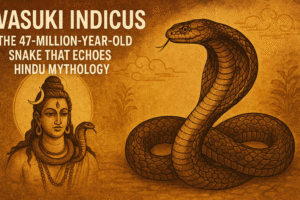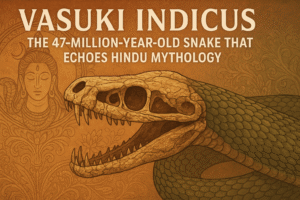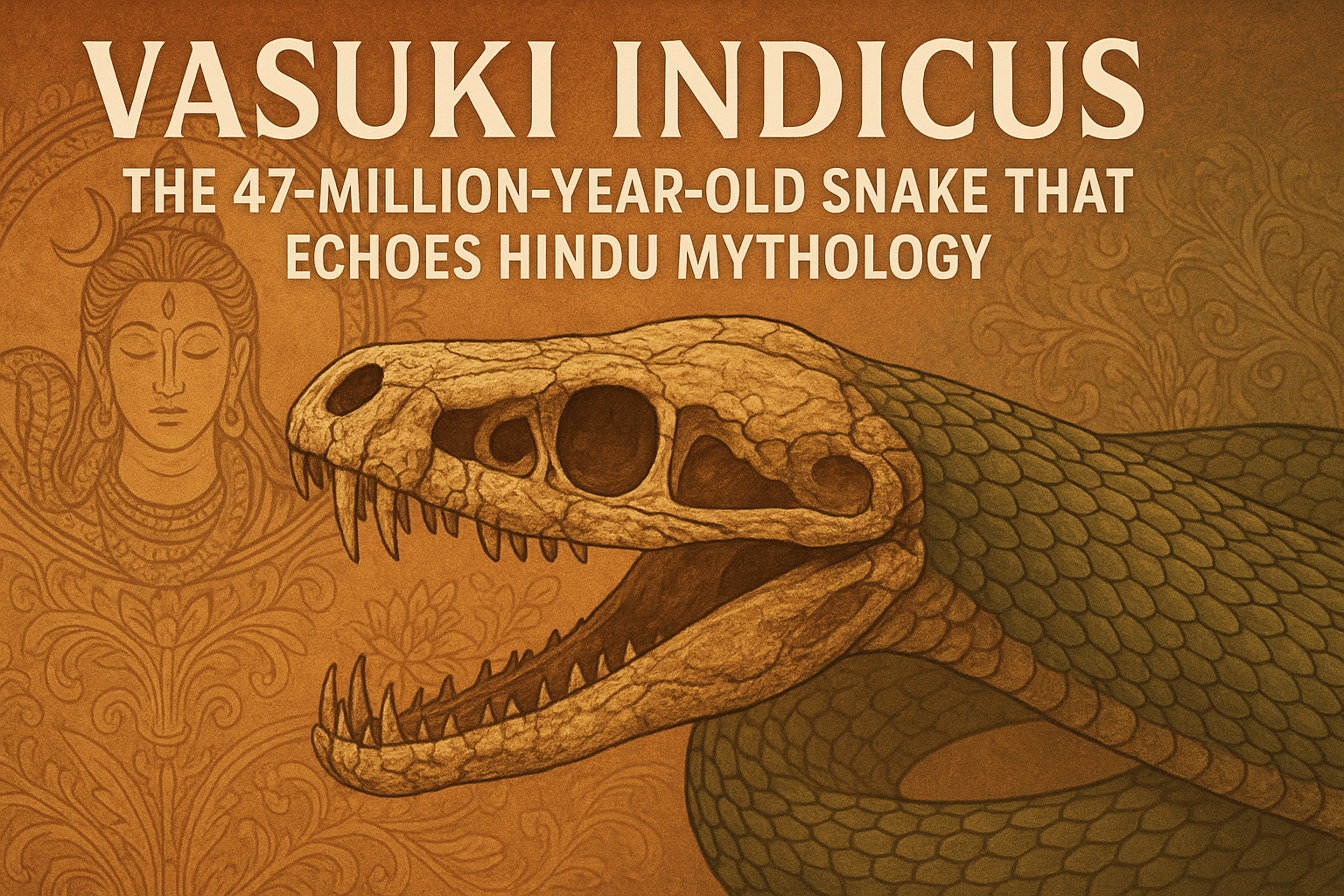
vasuki indicus
🐍 A Discovery That Shook the Scientific World
In a groundbreaking paleontological discovery, scientists have unearthed fossil remains of an ancient serpent species named Vasuki Indicus in Gujarat, India. Measuring an estimated 15 meters (50 feet) in length, this prehistoric snake might surpass the previously known Titanoboa as the largest snake to ever slither on Earth.
But what makes this discovery even more intriguing isn’t just its size—it’s the name Vasuki, which resonates deeply within Hindu mythology.
🧬 Vasuki Indicus: The Scientific Facts
Time Period: Eocene Epoch (~47 million years ago)
Location: Panandhro Lignite Mine, Gujarat, India
Estimated Length: 11–15 meters
Name Significance: Named Vasuki Indicus after the mythological serpent Vasuki, known from Hindu scriptures.
According to the scientists, Vasuki Indicus was a non-venomous constrictor, similar in behavior to modern-day pythons and anacondas. It likely preyed on large reptiles and mammals of its era.
🕉️ Vasuki in Hindu Mythology
In Sanatan Dharma, Vasuki is no ordinary serpent:
He is the King of Serpents (Nāgarāja).
Featured prominently in the Samudra Manthan (Churning of the Ocean), where he served as the rope wrapped around Mount Mandara, aiding the Devas and Asuras.
He adorns the neck of Lord Shiva, symbolizing power, energy, and control over desires.
Vasuki is often associated with cosmic balance and spiritual symbolism.
This mythological identity turns the fossil’s discovery into more than just science—it becomes a bridge to ancient spiritual lore.
Table of Contents
🔗 Myth Meets Fossil: A Deeper Connection
Naming a prehistoric serpent Vasuki isn’t just symbolic—it’s poetic.
For centuries, Hindu texts have spoken of gigantic serpents, mystical beings that reside in Patala (the netherworld), and even guardian Nāgas who protected sacred lands. The discovery of such a massive creature in Indian soil could be interpreted as a mythical echo in the natural world.
Could ancient seers and sages have had intuitive awareness of such beings through yogic insight or collective memory?
While science may not confirm mythology, and vice versa, discoveries like this allow us to honor both realms of knowledge.

vasuki indicus
📜 Lessons from the Past for Today
In an age of increasing interest in ancient wisdom, Vasuki Indicus represents:
The endurance of Indian mythology, now echoing through fossilized bones.
A call to re-explore our sacred texts with curiosity and openness.
A reminder that Sanatan Dharma isn’t just spiritual—it’s cosmically intertwined with nature, history, and time.
📈 Why This Matters for Modern Indians
For readers, researchers, and spiritual seekers, this topic is more than a scientific footnote—it’s a story of our cultural memory, our mythology, and our roots.
It shows the world that India isn’t just a land of mythology—but of deep-time history, spiritual science, and living wisdom.
📢 Final Thought
The discovery of Vasuki Indicus is not just about bones—it’s about bridging the spiritual and the scientific, the ancient and the modern, the mythic and the real. It’s about seeing our Itihasa (history) come alive in the soil beneath our feet.

vasuki indicus
🐍 FAQs on Vasuki Indicus: The 47-Million-Year-Old Snake That Echoes Hindu Mythology
❓What is Vasuki Indicus?
Vasuki Indicus is the name given to the fossil of a newly discovered prehistoric snake species in India. Estimated to be over 47 million years old, this colossal serpent may have reached a length of over 50 feet, potentially surpassing Titanoboa, which was previously considered the largest snake ever discovered.
❓Where was Vasuki Indicus discovered?
It was unearthed in Gujarat, India, at a lignite mine in the Kutch region. The fossil remains were found embedded in sedimentary rock layers that date back to the Eocene epoch (about 47 million years ago).
❓Why is it called Vasuki?
The snake is named after Vasuki, the mythical serpent from Hindu mythology who played a central role in the Samudra Manthan (Churning of the Ocean). In the myth, Vasuki acted as the churning rope, wrapped around Mount Mandara. The name was chosen to honor India’s rich spiritual traditions and the serpent’s mythological symbolism.
❓How does this discovery connect science and mythology?
The naming of Vasuki Indicus creates a powerful bridge between modern paleontology and ancient Hindu mythology. While the fossil is a scientific marvel, its name evokes deep cultural and religious symbolism, illustrating how ancient beliefs and modern discoveries can coexist and enrich one another.
❓How big was Vasuki Indicus?
Paleontologists estimate that Vasuki Indicus may have measured 11 to 15 meters (36 to 50 feet) in length and could have weighed around one ton. That’s longer than a city bus and heavier than most large land predators of its time.
❓Is Vasuki Indicus related to today’s snakes?
Yes. While it belongs to an extinct genus, Vasuki Indicus is considered a part of the Madtsoiidae family—an ancient group of large, non-venomous snakes. It likely moved slowly and ambushed prey, much like modern-day pythons and anacondas.
❓Is this discovery scientifically significant?
Absolutely. This is one of the most complete fossil finds of a giant snake in India, and possibly in all of Asia. It provides rare insight into the evolutionary history of reptiles and ancient ecosystems on the Indian subcontinent during the post-dinosaur era.
❓What does Vasuki Indicus tell us about prehistoric India?
It suggests that India was once home to tropical forests with abundant prey, suitable for sustaining such massive reptiles. This supports the theory that India was a biodiversity hotspot even millions of years ago, before colliding with the Asian continent.
❓Could Vasuki Indicus have inspired serpent myths in Hinduism?
While there’s no direct evidence, it’s possible that folk memory of large ancient snakes may have influenced serpent worship and legends. Serpents like Vasuki, Sheshnag, and Ananta have a strong presence in Sanatan Dharma. This fossil find may give new context to those age-old beliefs.
❓Are there any visuals or reconstructions of Vasuki Indicus available?
Yes! Several paleontologists and media outlets have created scientific illustrations and scale comparisons showing just how massive Vasuki Indicus was. Visuals often compare it to buses, humans, and other prehistoric creatures. These help bring this ancient serpent to life in modern imagination.
❓How does Vasuki Indicus compare to Titanoboa?
Titanoboa was discovered in Colombia and is considered one of the largest snakes ever recorded, measuring around 42–47 feet. However, some researchers suggest Vasuki Indicus may have been longer and heavier, depending on final fossil analysis. It could rewrite the record books.
❓Can Vasuki Indicus be seen in a museum?
Currently, the fossil remains are under study by Indian paleontologists. Once the research is complete, it’s likely that the fossils—or casts—will be displayed in India’s national or regional natural history museums, especially in Gujarat or Delhi.
Summary
🐍 Vasuki Indicus: The 47-Million-Year-Old Snake That Echoes Hindu Mythology
In a groundbreaking discovery that bridges ancient science and timeless mythology, Indian paleontologists have unearthed fossils of a massive prehistoric snake named Vasuki Indicus. Estimated to be around 47 million years old and measuring up to 15 meters (50 feet) in length, this serpent may be the largest snake ever discovered, surpassing even the famed Titanoboa.
What makes this discovery even more fascinating is its mythological resonance. The name “Vasuki” is a direct nod to Hindu mythology, where Vasuki is the revered king of serpents, famously coiled around Lord Shiva’s neck and a pivotal figure in the Samudra Manthan (Churning of the Ocean) legend.
Discovered in Gujarat’s lignite mines, Vasuki Indicus represents not just a scientific marvel but also a spiritual bridge—showing how mythological archetypes may have roots in ancient Indian ecosystems. Its massive body, estimated to weigh over 1 ton, suggests it was a slow-moving predator that likely ambushed its prey in dense, humid forests—similar to anacondas or pythons.
This discovery has ignited excitement not only in scientific circles but also among spiritual seekers, reminding us that India’s sacred stories may be more connected to natural history than we ever imagined.
Unlock the Ancient Wisdom of Sanatan Dharma – Join Us on YouTube!
👉 Subscribe now to Prachin Sanatan Dharma and embark on a journey of enlightenment.
Explore timeless teachings, spiritual insights, and cultural richness on our YouTube channel, Prachin Sanatan Dharma. Dive deep into the essence of Sanatan Dharma through captivating videos that inspire and educate.
Related Articles
- Restful Nights: Ayurvedic Remedies and Traditional Indian Practices to Overcome Insomnia and Late-Night Habits
- The Tridevi: Lakshmi, Saraswati, and Parvati – Their Roles and Powers
- “Divine Creatures of Ancient Indian Scriptures: Exploring the Role of Animals in the Vedas, Puranas, and Mahabharata”
- Nature and Spirituality: Exploring the Sacred Essence of the Himalayas, Ganga, and Other Natural Wonders”
- “Reviving the Gurukul System: Relevance and Lessons for Modern Education”
- “Exploring Greek and Indian Mythology: Similarities Between Greek and Indian Mythology “
- “Embracing Sattvic Living: Harmonizing Mind, Body, and Soul Through Food and Lifestyle”
- “Charity and Prosperity: Exploring the Concept of Daan and Its Financial Relevance in Modern Life”
- How to Build an Eco-Friendly Home Inspired by Vastu Shastra
- Comparison of Ancient and Modern Sports: How Traditional Sports Have Influenced Contemporary Games
- “Timeless Lessons from Ancient Tales: Linking Samudra Manthan and Ganga’s Descent to Modern Ecological Challenges”
- “Reviving Sanskrit: How AI is Preserving Ancient Languages for the Future”
- “Mathura: The Sacred Land of Lord Krishna’s Divine Leelas”
- Investing for Future Generations: Lessons from Indian Traditions on Legacy Building and Wealth Preservation
- “Ancient Indian Wisdom: Timeless Lessons for Tackling Today’s Climate Crisis”
- “Artificial Intelligence and Spirituality: Transforming Ancient Practices for the Modern World”
- “Gold and Real Estate in India: Timeless Assets Shaping Financial Strategies”
- Tradition Meets Innovation: The Evolution of Technology in Hindu Rituals
- End-of-World Myths: Exploring Kali Yuga in Hinduism and Ragnarök in Norse Mythology
- Garuda, Pegasus, and Dragons: The Universal Ties of Mythical Beasts Across Cultures
- “Ancient Vimanas: Mythical Flying Machines or Evidence of Advanced Technology?”
- Time Travel in Hindu Mythology: The Fascinating Tales of Kakudmi and King Raivata
- “Divine Feminine Power in Hindu Mythology: The Legends of Durga, Saraswati, and Lakshmi”
- “Divine Beings of Sanatan Dharma: The Spiritual Significance of Sacred Animals in Hinduism”
- “Symbolism in Mythological Art: Unlocking Hidden Meanings in Ancient Temple Carvings”
- “Exploring Technological Advancements in Ancient India and Civilizations: Vimana, Metallurgy, & Water Management systems”
- Unveiling the Mysteries: Ancient Temples of Sanatan Dharma , Mysterious Temples of India
- “The Scientific Knowledge of Sanatan Dharma: Ancient Wisdom Meets Modern Science”
- Ancient Indian Sports and Games: Celebrating a Legacy of Skill, Strength & Strategy”
- “Exploring the Cosmic Link: The Connection Between Astronomy and Vedic Astrology”
- The Power of Sanskrit: Unlocking the Divine Language of the Gods
- “The End of Kaliyuga: A Sanatan Insight into the World’s Final Chapter”
- Explore more articles on Prachin Sanatan Yuga.
In a groundbreaking discovery that bridges ancient science and timeless mythology, Indian paleontologists have unearthed fossils of a massive prehistoric snake named Vasuki Indicus. Estimated to be around 47 million years old and measuring up to 15 meters (50 feet) in length, this serpent may be the largest snake ever discovered, surpassing even the famed Titanoboa.
In a groundbreaking discovery that bridges ancient science and timeless mythology, Indian paleontologists have unearthed fossils of a massive prehistoric snake named Vasuki Indicus. Estimated to be around 47 million years old and measuring up to 15 meters (50 feet) in length, this serpent may be the largest snake ever discovered, surpassing even the famed Titanoboa.
In a groundbreaking discovery that bridges ancient science and timeless mythology, Indian paleontologists have unearthed fossils of a massive prehistoric snake named Vasuki Indicus. Estimated to be around 47 million years old and measuring up to 15 meters (50 feet) in length, this serpent may be the largest snake ever discovered, surpassing even the famed Titanoboa.
In a groundbreaking discovery that bridges ancient science and timeless mythology, Indian paleontologists have unearthed fossils of a massive prehistoric snake named Vasuki Indicus. Estimated to be around 47 million years old and measuring up to 15 meters (50 feet) in length, this serpent may be the largest snake ever discovered, surpassing even the famed Titanoboa.
